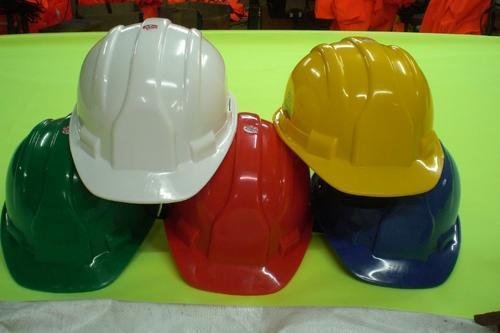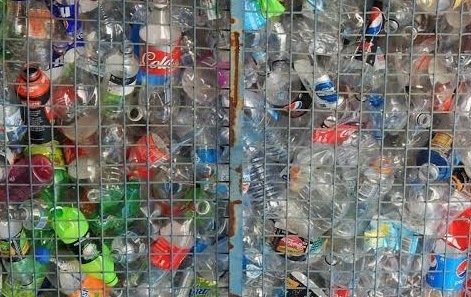Safety Helmets Made By Polymeric or Plastic Material
Protective or Safety Helmets:

Introduction: Helmets has been used since early times to protect people in battle. Before the introduction of steel and aluminum, they were made of iron and beaten into shape. These days helmets are not only used by the police and army but have also seen widespread use in more peaceful areas like building, cycling, horse riding, snowboarding, boxing etc. Modern helmets are mainly of polymer construction, but their design varies depending on the application and manufacturing process.
Purpose of Using:
An Industrial hard hat is a helmet worn to protect the head of a worker from falls or from impacts by sharp or blunt objects. Typical users include construction laborers, repairmen, and warehouse workers.
 Climbing Helmets:
Climbing Helmets:
The requirements for a climbing helmet are similar to those of a hard hat (although a climber must be able to trust on their helmet even after it has suffered an impact). The first designs for climbing helmets were, therefore, not much different from a hard hat. Since then, considerable effort has been put into making climbing helmets more comfortable and lightweight. Usually, this hat is made by polymer material Polycarbonate but at this time it has been developed by Glass fiber or Carbon fiber reinforced polymer for reducing weight.
Carbon Fiber reinforced polymer helmets costs are little high compared to polycarbonate but the cost is no matter often the safety of human being.
Cycling Helmets:
As well as protecting from small knocks, a cycle helmet must protect against the large impact on the head received during a crash. In this case, it doesn’t matter if the helmet is permanently damaged (all manufacturers recommend replacement after an accident), but it must absorb lots of energy. The best materials for this are foams – they absorb lots of energy when they are crushed. The main impact absorbing the material in a cycling helmet is, therefore, a molded block of polystyrene foam, usually with a polycarbonate covering. These materials are easily shaped – cycling helmets often have striking shapes to improve their aerodynamic performance.
Manufacturing Process:
Injection molding is the best technique, which is mostly used to make hard hat helmets. And the process is followed as:
- In the injection molding technique, there has one core which is called male functioning part and another one is Cavity which is called the female part. Electric lines are connected to the mold, as line carrying chilled water that will cool the mold.
- High-density polyethylene pellets are pulled from supply hopper thru vacuum system & pigments are drawn from another supply hopper with the ratio of 97% & 3% to the extruder, the pellets are heated to melt them.
- The molten plastic is injected into the mold to form the hard hat shell. The press opens the mold and ejects the shell onto a conveyor belt.
- A worker picks the shell up and cuts off the flash (a lump formed where the molten plastic entered the mold). The worker glues a label inside the shell; the label identifies the manufacturer and the appropriate ANSI type and class designations.
- Component parts of the suspension system are produced. Injection molding machines form headbands, plastic “keys” that will be used to attach the suspension system to the shell, and nylon strips and gears for the ratchet mechanism that will allow head-band size adjustment to fit the hard hat user. Nylon webbing (0.75-1 in [1.9-2.5 cm] wide) from large spools is fed into a cutting machine that produces strips of the appropriate length (approximately 15 in [38 cm]).
- A die-cutting machine produces brow pads. A worker threads one end of a webbing strap through a slot in the end of a key. The worker folds the strap end back and sews it to the strap with a buttonhole machine,
- Securing the key in a loop of the strap. The same process is repeated on the other end of the strap. Depending on the model being produced, the appropriate number (4, 6, or 8) of nylon straps is arranged in a star pattern on a holding fixture, and they are secured to each other by a line of stitching at the crossover point. Alternatively, they may be threaded through a slotted, circular pad (called a crown cushion) that will rest on top of the user’s head.
- A worker inserts both ends of the headband strip into the ratchet mechanism.
- A worker attaches a brow pad to the front of the headband by folding its tabs over the headband and hooking slots in the brow pad over knots swelling from the headband.
Apart from injection molding some type of helmets made by the technique of compression molding also.
Raw Material Used:
For making industrial hard hat helmets, Polycarbonate shortly called PC or ABS material are the best suit. For the best impact resistance, lightweight, High toughness, less fracture, and easy processing.

Best Brands:
These below-listed brands are capturing good quality of safety or protective helmets.
- Karam/ Karam safety Helmet PN501
- Supreme Safety
- Anti Riots
- Welding Face Shield
- Fire Fighter Helmets
- Vent





I have noticed you don’t monetize your website, don’t waste your traffic, you can earn additional bucks every month because you’ve got
high quality content. If you want to know how to make extra money, search for:
Boorfe’s tips best adsense alternative
Hi, just wanted to mention, I loved this article. It was inspiring.
Keep on posting! https://orcid.org/0000-0001-8469-1280
thanks a lot. for appreciating and visiting the site of polymeracademy.com. definitely will update as you desired and help to people.
thanks a lot for appreciating
I am sure this post has touched all the internet viewers, its really really fastidious post on building up new blog.
thanks for your appreciation.
Thanks for the excellent manual
It’s my pleasure sir
Thanks, it is very informative
thank you for visiting this site
That’s a great Job you Mr.Deepak, but don’t copyright the sentence from legal websites, its harmful to you.
Very informative post about safety helmets. You have covered all the things related to safety helmet.